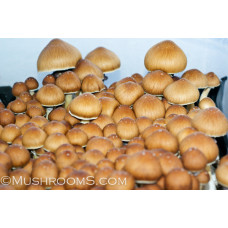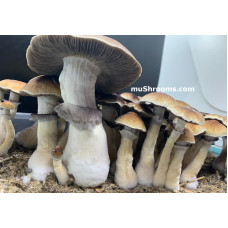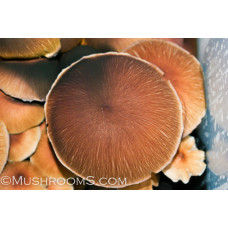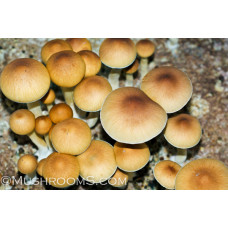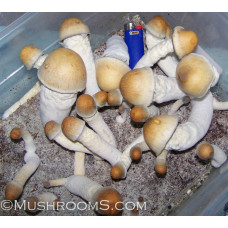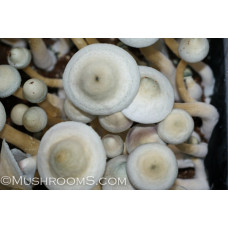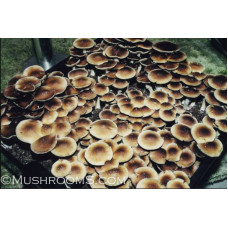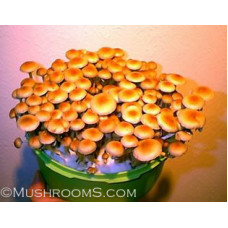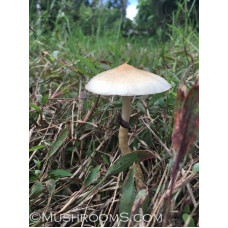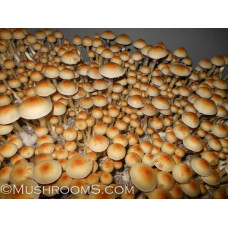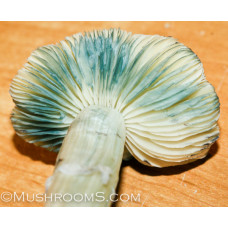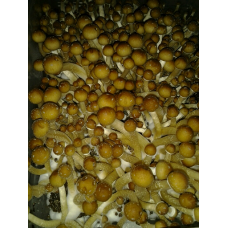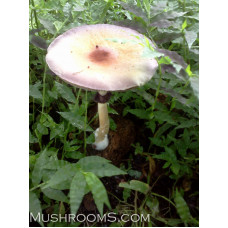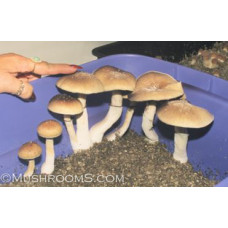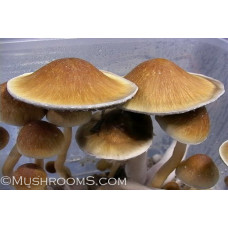Psilocybe Cubensis Spore Syringes

The psilocybe cubensis are the most common psilocybe mushrooms on earth. We carry spores from psilocybe cubensis from all around the world, many of which we have collected ourselves from traveling the globe and working closely with other mushroom enthusiast who enjoy collecting spores and documenting mushrooms in their natural habitat.
Cubensis is typically a warm and hot weather mushroom, but has also been seen growing in cooler climates and temperatures. In nature, typically it grows in tropical and sub-tropical climates in the 75F to 100F temperature range, as long as there is plenty of rain or morning dew. Another reason these mushrooms are so wide spread is because their natural habitat is on wide range of substrates. They are typically found around farms or ranches where there is livestock such as horses,cattle, buffalo or even elephant dung. They especially thrive in grassy pastures with plenty of dung. If a pasture does not have cubensis growing there, then most of the time it's merely a matter of introducing the spores to the area when there is warm weather and plenty of rain or morning dew. A reliable source told us of some cow fields in the arid desert climate of that used to not have cubensis growing until the spores were introduced. Within a few years there were plenty of wild cubensis growing in the spring time. They were not big mushrooms but the mycelium was doing it's job in nature, breaking down dead and decaying matter such as dung. Our friend thought he would see the cubensis mushrooms growing in the summer from the monsoon rains, but the intense heat would dry up the rain water to quickly. Instead they thrived in the spring from the morning dew. It really has to do with micro climates and the grass helps hold in moisture to make mini micro climates. Another reason this mushroom is so common around ranches is because it grows on any cereal straw and just about any grain. The mycelium from this fungi spreads quickly and is a great dung decomposer. This fungi can quickly turn aging livestock dung into composted rich soil, which in turn feeds the grass, which feeds the livestock. The spores are deposited on the grass the livestock eat, then pass through the animals system to start the fungi’s life cycle over again. This mycelia breaking down dung held reduce the smell of dung and is a blessing on a ranch or farm.
Microscopic Features: Spores dark purplish brown to violet brown in deposit, subellipsoid, 11.5-17 by 8-11 u. Basidia 2- or 3-spores, but usually 4-spored. Pleurocystidia nearly pear shaped, sometimes mucronate, 18-30 by 6-13 u. Cheilocystidia fusoid-ventricose with an obtuse or subcapitate apex, sometimes sublageni form, 17-32 by 6-10 , with the narrow necks 3-5 u broad. One rare cubensis strains named Columbia “rust spore” actually drops almost reddish rust colored spores but this strain is very unique! We do carry spores of that strain from time to time.
DISCLAIMER: Psilocybe mushroom spores are sold for legal microscopy purposes, food seasonings and artistic purposes. Pictures and information is for educational purposes.
Golden Teachers Cubensis Spore Syringe
Spores from the Golden Teacher mushrooms have been spread throughout the world for many ye..
$21.98
Tidal Wave Cubensis Spore Syringe
Can you swim in an ocean of psychedelic bliss? We know you can because a Tidal Wave of shroomy fun i..
$23.96
Corumba Brazil Cubensis Spore Syringe
The spores from these cubensis mushrooms come from the magical country of Brazil. I've traveled to m..
$20.50
Mazatapec Cubensis Spore Syringe
Another fantastic cubensis from Mexico is these spores collected by the Mazatec Indians near Huautla..
$20.50
Penis Envy Cubensis Spore Syringe
Mushrooms.com is one of only a few spore vendors that carry the original true AUTHENTIC Pe..
$24.97
AA Plus Albino Cubensis Spore Syringe
The AA+ Albino Cubensis mushroom truly deserves more attention. In our humble opinion we think ..
$21.95
B Plus Cubensis Spore Syringe
The famous B+ cubensis is our best selling spores. This fungi is the most versatile cubensis ar..
$21.99
Treasure Coast Cubensis Spore Syringe
The Treasure Coast spores come from a nice cubensis from the east coast of Florida. It’s named after..
$20.50
Arenal Volcano Cubensis Spore Syringe
I am excited to introduce another original cubensis spores strain from my 2016 travels, the Arenal V..
$20.50
Brazil Cubensis Spore Syringe
This strain of mushroom spores from Brazil comes from a very magical place, the Amazon rain for..
$18.99
Z-Strain Cubensis Spore Syringe
The Z-Strain cubensis originated from a spore vendor who went by “the keeper”. One really good ..
$20.50
Escondido Mexico Cubensis Spore Syringe
This magical mushroom of cubensis spores was originally found by Fishy growing on a coffee plan..
$20.50
Purple Mystics Cubensis Spore Syringe
The Purple Mystics cubensis originates from East Plant City Florida. TheHawksEye.com (now mushrooms...
$20.50
Ecuador Cubensis Spore Syringe
Coming to you all the way from 3500+ feet up in the Ecuador mountains is the beautiful Ecuadorian cu..
$20.50
Mexi-Cub Cubensis Spore Syringe
These cubensis spores were originally found in Southern Mexico, from our friend Mr. G. ..
$20.50

